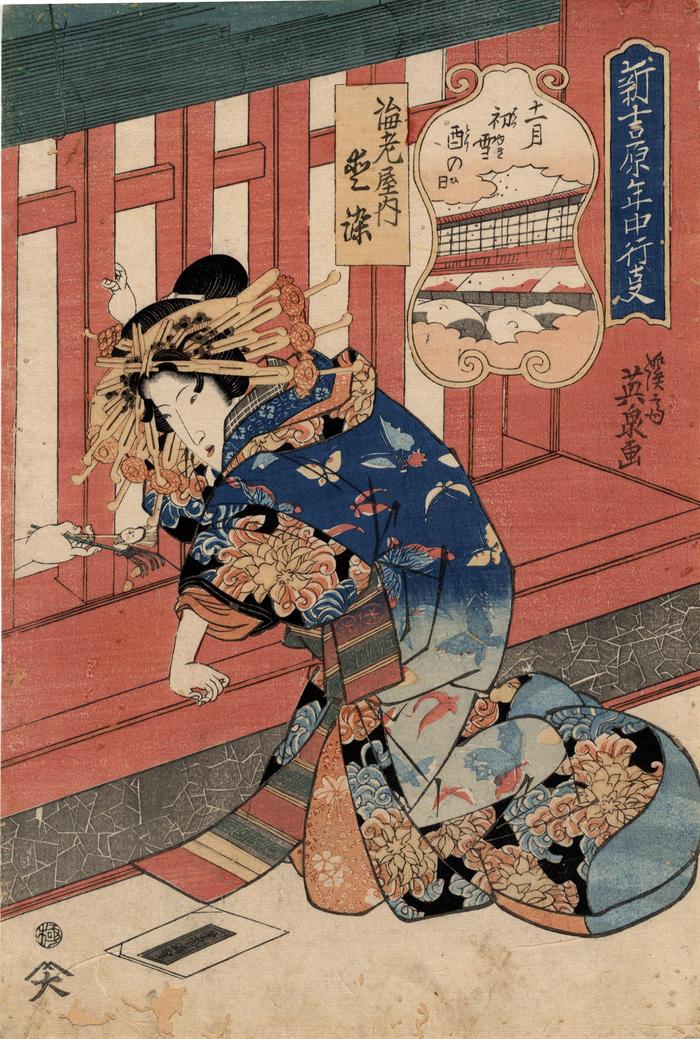Keisai Eisen (渓斎英泉) (artist 1790 – 1848)
The Eleventh Month (十一月), First Snowfall on the Day of the Rooster, the Tori-no-hi Festival (Jūichigatsu, hatsuyuki, tori no hi - 初雪酉の日): Aizome (相染) of the Ebiya (海老屋), from the series Annual Events in the New Yoshiwara (Shin Yoshiwara nenjū gyōji - 新吉原年中行事)
ca 1828 – 1829
10 in x 14.75 in (Overall dimensions) color woodblock print
Signature: Keisai Eisen ga (渓斎英泉画)
Publisher's seal: Daikokuya (Marks U032 Seals 02-052)
Censor seal: kiwame
Museum of Fine Arts, Boston
Google maps - Yoshiwara Shrine - one of the only signs of where this famous district was
Lyon Collection - another print from this series
Cleveland Museum of Art - a print of Aizome by Eizan
Museum of Fine Arts, Boston - another print of Aizome by Eisen
Lyon Collection - another print underwritten by Bien Senjokō face powder Schaap and van den Bosch date the series between 1818 and 1830. They also say that there are 13 known prints in this series.
****
The oiran Aizome conversing with a peddler who is offering her festival items through the vertical slats at the front of her brothel. One item is an unadorned miniature rake and the other is a miniature rake with adorned with a mask of Okame.
Lying on the floor in front of Aizome is a packet/envelope of the white face powder sold by Mr. Sakamoto. It was called Bien Senjokō (美艶仙女香) and was named after a famous onnagata, Segawa Kikunojo III (1751-1810). One of his poetry names was Senjo (仙女). Sakamoto was a known patron of the production of ukiyo prints, especially those by Eisen, which he used to advertise his products.
Aizome's red undergarment, now pink with age, is decorated with cherry blossoms and maple leaves overlying a overall hemp leaf pattern.
****
Sebastian Izzard noted, about a different series by Kunisada, that one of the prints in this set displays "...a packet of Bien Senjokō (Beautiful fairly maiden fragrance), a popular cosmetic whose brand name was based on the poetry name (haimyō) Rokō, of the Kabuki actor Segawa Kikunojō V (1802-32), one of Edo's leading contemporary onnagata, or players of female roles. It was manufactured by Sakemoto, a man who often used beauty and landscape prints to promote his products. Indeed, selling this kind of advertising was a common way for publishers, such as Azumaya to defray the expenses of producing prints."
****
"One of the most effectively advertised products was a white face powder (oshiroi) called Senjokō made by the Sakamoto family in the heart of Edo. Sakamoto's ancestors had been part of the ukiyo-e print world so he was particularly adept at the use of print in promotion. He was responsible for many examples of what we would now be called 'product placement'. The name Senjokō appeared innocently in prints as a sign on a wall or discarded wrapper, or more overtly with copy extolling its virtues in the background of a 'beauty' print."
Quoted from: Japanese Popular Prints: From Votive Slips to Playing Cards by Rebecca Salter, pp. 73-74.
"Around 1821 Senjokō face powder (also called Biensennyokō became the leading brand for the Sakamoto store and as part of the advertising campaign the name appeared in numerous prints and novels making sure it was identified with the idols of the day." Ibid., p. 74
***
Illustrated in color in 原色浮世絵大百科事典 (Genshoku Ukiyoe Daihyakka Jiten), vol. 11, p. 76, #353.
***
There is another copy of this print in the Ota Memorial Museum of Art.
beautiful woman picture (bijin-ga - 美人画) (genre)
Daikokuya (大黒屋) (publisher)
